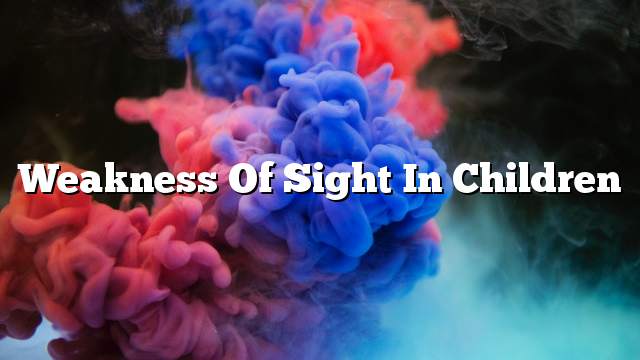Weakness of sight in children
One of the most important concerns for parents is their health. They always try to be sure that they are at their best, and that all of their body organs remain healthy and normal, including, of course, healthy eyes, which include their ability to see naturally and clearly . In this article, we will present the symptoms of child weakness, its causes, and ways to maintain their eyesight.
Symptoms of poor vision in children
Symptoms of poor vision in infants
- Swelling in the eyelids.
- The presence of ulcers on the eyelids or around.
- The inability to contact people around him with his eyes.
- The inability to observe or follow moving objects.
- Spasms of the movements of his eyes.
- Lack of coordination between the movements of his eyes.
- Tilt his head when doing things.
- Close one eye when looking at things.
- Frequent tears in cases of crying.
- Over-staring.
- Rub his eyes continuously and repeatedly.
- Sensitivity of bright radioactive lights.
Symptoms of poor vision in school-age children
- Excessive approach of the book to try to see, with the difficulty of reading.
- Lack of ability of the child to distinguish between colors, or face difficulty in discrimination.
- Difficult to know faces, and difficult to see things.
- Difficult to see tags.
- Visibility in the daytime more than the evening.
- The child sits very close to the TV when watching.
- The constant complaint of tired eyes and stress.
- The constant complaint of eye strain after reading or studying.
Causes of poor vision in children
- Refractive errors, namely: myopia, longitudinal, and astigmatism (astigmatism), and this need medical glasses as a treatment.
- Strabismus, where a lot of lazy time occurs in the perverted eye.
- The presence of certain diseases related to the eye, which are often caused by congenital defects or eye infections or injuries, an example of eye diseases: opacity in the cornea, opacity in the lens of the eye, and a problem in the retina.
- Infection of the child with some diseases leading to weakness of the eye, such as: meningitis, and lack of oxygen at birth, and diseases of the nervous system in general.
- Hereditary diseases, which either appear at birth, or in childhood, or after puberty.
Tips to keep children looking
- Provide adequate lighting for the child when reading or using a computer.
- Help the child to hold the material he reads, by leaving a distance between his eyes and between them about 45 or 55 centimeters.
- Get comfortable every period of time while reading (almost every five minutes), so rest your eye.
- Regular and regular medical examinations of the eyes since childhood, ie since the child reaches the age of the year.
